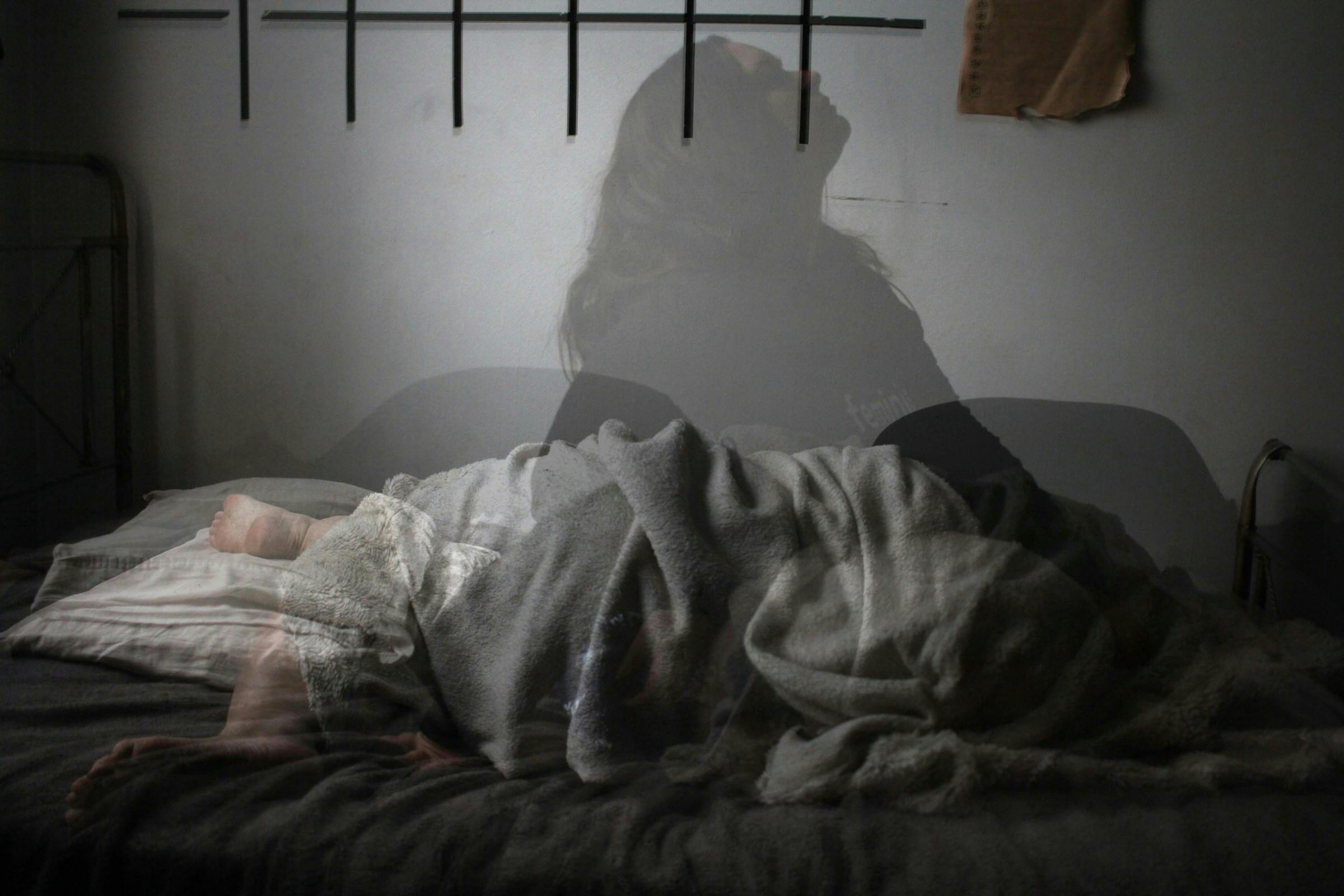Sleep Paralysis Demon: What It Is, Why It Happens, and How to Stop It
By Karyn O.
Reviewed by Dr. Daniel Uba, MD
Published Aug 7, 2025
9 min read

Imagine waking up in the middle of the night, fully aware of your surroundings, but completely unable to move. Your eyes are open. You can see your room. Maybe the ceiling fan is spinning. But your body won’t respond. And worse, it feels like something is in the room with you—watching. Sometimes it feels like a weight pressing down on your chest. You try to scream, but no sound comes out. Panic sets in.
That’s what many people describe as an encounter with a “sleep paralysis demon.”
It’s a terrifying experience—especially if you don’t know what’s happening. For centuries, people around the world have described similar episodes, often blaming evil spirits, demons, or even aliens. But thanks to modern science, we now have a much clearer understanding of what’s really going on—and how to stop it.
In this article, we’ll explore everything you need to know about sleep paralysis, including what causes it, why it often feels so terrifying, what the so-called "sleep demon" really is, and how to prevent it from happening in the first place.
What Is Sleep Paralysis?
Sleep paralysis is a temporary inability to move or speak that happens when you’re either falling asleep or waking up. Even though you’re conscious—fully awake mentally—your body is still in a state of sleep. This strange mismatch between the mind and body can feel very unsettling.
It happens because during a specific stage of sleep called REM (Rapid Eye Movement), your brain intentionally stops your muscles from moving. This natural form of “paralysis” prevents you from physically acting out your dreams. It’s a normal, protective function of the body. The problem is, sometimes your brain wakes up before your body does.
When that happens, you regain awareness, but your muscles are still locked in this REM state. You feel trapped—awake but unable to move, speak, or even open your mouth to call for help.
This in-between state—between dreaming and waking—is where sleep paralysis occurs. And it’s also the state where hallucinations often creep in.
Why Sleep Paralysis Feels So Terrifying
For many people, the experience is more than just frustrating or strange—it’s absolutely terrifying. And one of the main reasons is that during sleep paralysis, you may have vivid hallucinations that seem real.
These aren’t the kind of dreams you forget in the morning. They feel like they’re really happening. You might hear footsteps, feel pressure on your chest, or sense a shadowy figure lurking nearby. Some people even describe the sensation of being choked, touched, or pinned down by a ghost-like force.
These hallucinations can involve multiple senses. You may feel a presence, hear whispers, see shapes moving in the room, or experience a suffocating sensation as if something is sitting on your chest. And because you can’t move or speak, the fear builds rapidly.
This terrifying combination of paralysis and hallucinations is what has led people across cultures and centuries to believe they were being attacked by demons or haunted by evil spirits. And in the moment, it really does feel like that.
The “Sleep Demon” Explained: Where the Myth Comes From

The idea of a sleep paralysis demon isn’t new. It’s been around for centuries, and almost every culture has its own version of the story.
In medieval Europe, people believed that a creature called an "incubus" or "succubus" was responsible for these nighttime attacks. These demons were thought to sit on the chests of sleeping people, suffocating or tormenting them. In Scandinavian folklore, the “Mare” (which is where the word “nightmare” comes from) was a malicious entity that crept into people’s rooms while they slept. In Japan, it’s called "Kanashibari." In Nigeria, some communities call it "the devil on your back."
Across different parts of the world—from Brazil to China to Egypt—similar stories have been passed down, always involving some dark presence that comes to people in their sleep.
The strange thing is how similar these stories are, even though they come from places with no historical contact. This global consistency is part of what makes the sleep paralysis phenomenon so fascinating.
So, what explains this?
Scientists believe that during sleep paralysis, the brain is still partly dreaming. That means your imagination is still active. At the same time, because you’re aware of your surroundings and feel helpless, your brain may interpret that helplessness as danger—and it fills in the blanks by creating the feeling of a threatening presence.
In other words, your mind tries to make sense of what’s happening—and often, it fills that gap with something scary.
Is It Really a Demon? Or Something Else?
Let’s clear this up: No, sleep paralysis is not caused by demons, ghosts, spirits, or aliens.
Even though the experience feels incredibly real and terrifying, it’s not supernatural. It’s biological. It’s a misfiring in your sleep-wake cycle, not a spiritual attack.
Sleep researchers classify sleep paralysis as a type of parasomnia. Parasomnias are unusual behaviors that happen during sleep, like sleepwalking or night terrors. In the case of sleep paralysis, the unusual behavior is waking up before your body is ready.
This disconnect is purely neurological. Your brain wakes up, but the system that controls muscle paralysis during REM sleep is still turned on. Add a bit of lingering dream activity, and boom—you get what feels like a ghostly encounter.
So while it might feel like there’s something sitting on your chest, there’s a completely natural, scientific explanation behind it.
What Causes Sleep Paralysis?
Sleep paralysis can happen to anyone, but certain factors make it more likely. The most common triggers are related to your sleep habits and stress levels.
If you’re not getting enough sleep, if your schedule is constantly changing, or if you’re under a lot of emotional pressure, your sleep cycles can become disrupted. And when your sleep isn’t following its normal rhythm, that’s when problems like sleep paralysis are more likely to occur.
Sleeping on your back also seems to increase the chances of having an episode. No one’s sure exactly why, but one theory is that this position may put more pressure on your chest and make you more aware of your breathing, which could contribute to the sensation of being pinned down.
Other possible causes include irregular sleep patterns (like staying up all night or pulling shifts at work), jet lag, certain medications, or mental health conditions like anxiety, PTSD, or depression.
It can also run in families. Some studies suggest that genetics may play a role, although this isn’t fully understood yet.
RELATED READ: The 4 Stages of Sleep Explained: What Really Happens During a Sleep Cycle
Who’s Most at Risk?
Sleep paralysis can affect people of all ages, but it’s especially common in teenagers and young adults. In fact, many people report their first experience during adolescence.
If you’re in a high-stress period of life, like exams, new jobs, or dealing with emotional upheaval, you may be more likely to experience it.
People with disrupted sleep schedules—like shift workers, college students, frequent travelers, or new parents—are also at higher risk.
Those who have sleep disorders such as insomnia, narcolepsy, or obstructive sleep apnea may also be more prone to episodes. In narcolepsy especially, sleep paralysis is a common symptom.
How to Stop Sleep Paralysis: What Actually Works

The good news is that sleep paralysis is not dangerous, and for most people, it’s something that can be managed—or even completely avoided—with some changes to your sleep habits.
The most important step is to focus on getting regular, quality sleep. That means going to bed and waking up at the same time each day—even on weekends. Creating a calming bedtime routine and avoiding screens or bright lights at night can help your body wind down more naturally.
Reducing stress and anxiety can also make a big difference. Practicing relaxation techniques like deep breathing, mindfulness meditation, or journaling before bed can help you feel calmer and reduce the likelihood of your brain misfiring during sleep transitions.
If you tend to sleep on your back, try switching to your side. This simple change has helped many people reduce episodes or avoid them altogether.
Avoid caffeine or heavy meals too close to bedtime. Alcohol and some recreational drugs can also disrupt your sleep architecture and make sleep paralysis more likely.
If you’re dealing with mental health challenges, addressing them directly—through therapy, counseling, or support groups—can improve not only your mood but also your sleep.
What to Do During a Sleep Paralysis Episode
If you find yourself in the middle of an episode, it can feel terrifying—but remember, it will pass.
Try to stay calm and remind yourself that this is a temporary and harmless condition. It can be helpful to focus on trying to move a small part of your body—like a toe or a finger. Many people report that once they’re able to move even a little, the rest of their body quickly follows.
Focusing on your breathing can also help. Try to breathe slowly and deeply. Panicking can make the episode feel longer and more intense, so the more you can stay calm, the better.
You can also try closing your eyes. Sometimes, the hallucinations are driven by visual input, and cutting off that stimulation can help reduce fear.
If you live with someone, consider telling them about your experiences so they understand what’s happening if they hear you struggling or breathing heavily during the night.
When Should You See a Doctor?
While sleep paralysis is common and usually harmless, you should talk to a doctor or sleep specialist if you’re having episodes frequently—especially if they’re disrupting your ability to get good sleep or affecting your mental health.
You should also seek help if you experience other symptoms like sudden muscle weakness during the day, excessive daytime sleepiness, or vivid hallucinations while falling asleep or waking up. These could be signs of narcolepsy or another sleep disorder.
A sleep study (called a polysomnogram) can help doctors understand your sleep patterns and determine if there’s an underlying issue.
Treatment usually focuses on improving sleep hygiene and addressing any contributing mental health or medical issues. In some cases, medication may be recommended—but for most people, lifestyle changes are enough.
Final Thoughts: You’re Not Alone—And You’re Not Haunted
Sleep paralysis can be terrifying, especially the first few times it happens. The feeling of being frozen in place, the strange hallucinations, and the sense of dread can leave a deep impression. But you’re not alone. Millions of people experience it. And the truth is, there’s nothing supernatural about it.
The “sleep paralysis demon” is just your brain reacting to a moment of confusion between sleep and wakefulness. It might feel real, but it’s just a trick of the mind.
With better sleep habits, stress management, and a little knowledge, you can reduce your chances of it happening—and learn to handle it calmly if it does.
So next time you wake up and feel stuck, remember: it’s not a ghost or a demon. It’s your brain catching up with your body. And it will pass.
Sleep well.
Share this article

Sleep Hygiene: Proven Habits for Better Sleep, Energy, and Health
Lilian E.
Sep 28, 202512 min read

Low Sodium Diet: Simple Guidelines, Food Lists, and Tips for Better Health
Lilian E.
Sep 30, 202512 min read

Tips for Staying Healthy: 12 Simple Habits for Energy, Longevity, and Better Living
Editorial Team
Sep 30, 202510 min read

Best-in-class care is a click away
Find everything and everyone you need to reach your metabolic health goals, in one place. It all makes sense with Meto.
Join Meto